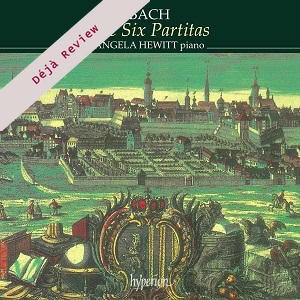
Déjà Review: this review was first published in September 2001 and the recording is still available.
Johann Sebastian Bach (1685-1750)
The Six Partitas
Partita No 1 in B-flat major, BWV 825
Partita No 2 in C minor, BWV 826
Partita No 4 in D major, BWV 828
Partita No 3 in A minor, BWV 827
Partita No 5 in G major, BWV 829
Partita No 6 in E minor, BWV 830
Angela Hewitt (piano)
rec. 1996/97, Beethovensaal, Hanover, Germany
Hyperion CDA67191-2 [2 CDs: 143]
Bach’s keyboard partitas were his first published works, his Opus 1. These six suites were actually the last suites Bach wrote for keyboard, and owe a great deal to French influence. These are relatively popular works, and have been recorded by most of the world’s leading pianists. Angela Hewitt has recorded most of Bach’s keyboard works, and, like the others in her Hyperion series, this is an excellent recording.
From the very first notes, one can hear that Angela Hewitt has chosen a more sprightly, less profound reading of these works. The first partita, probably the closest to the French suites in style and melody, comes off here with a pastoral sound, where the notes dance around lightly, and the melodies sing. But she is also at home in the more energetic movements, such as the gigue of the 3rd partita, with its rhythmic three-part fugue.
Her choice of tempi is quite interesting – where many performers choose to play quickly, perhaps just to sound more impressive, Hewitt adapts more closely to the feel of the music. In the minuets of the first partita, for example, she plays slower than many, but this tempo is ideal for the quirky melodies in these movements. However, I am disappointed by Hewitt’s choice of tempo for the allemande of the 4th partita – it is too fast, especially compared to her choices for other melodic movements. This is music that truly needs time to express its discourse, and she just goes too fast. The same is the case for the allemande of the 5th partita, which also seems too fast.
Hewitt uses the full dynamic range of the piano, providing many interesting variations in tone between the first expositions of movements and their repeats. And there is an interesting contrast between Hewitt’s forcefulness in some movements and her light touch in others. The opening overture of the 4th partita, arguably the best of the lot, comes across with a great deal of vigour and energy. The following allemande, perhaps the most beautifully melodic movement in any of Bach’s keyboard works, is played with a much lighter touch, much more graceful and fluid, although, as mentioned above, the tempo does not seem quite right.
While Hewitt may be accused of using a great deal of ornaments, this is never excessive, in my opinion. A fine example of her ornamentation can be heard in the courante of the second partita, where the ornamentation is pushed to its limit, but never overcomes the music. There is a thin line between judicious ornamentation and excess, and Hewitt comes close to that line without crossing it.
If one movement were to be singled out as an example of Hewitt’s performance of these works, it would undoubtedly be the opening toccata of the 6th partita. From the opening section, with its energy and force, to the more subtle fugue, with its varied dynamics, she maintains the same tempo throughout the movement to attain unity. The long runs of the opening and closing of this section are majestic, and her choices of ornamentation go with the grain perfectly. This is a beautiful performance of one of the emblematic movements of this set of works.
Angela Hewitt shows, yet again, that she is one of the best interpreters of Bach on the piano of our time. While there are some minor elements that seem a bit out of character, this set is one of the best available for piano, if not the best.
Another excellent recording by Angela Hewitt, who shows her mastery of Bach’s keyboard music. If you like Bach on piano, this is for you.
Kirk McElhearn
Help us financially by purchasing from




















